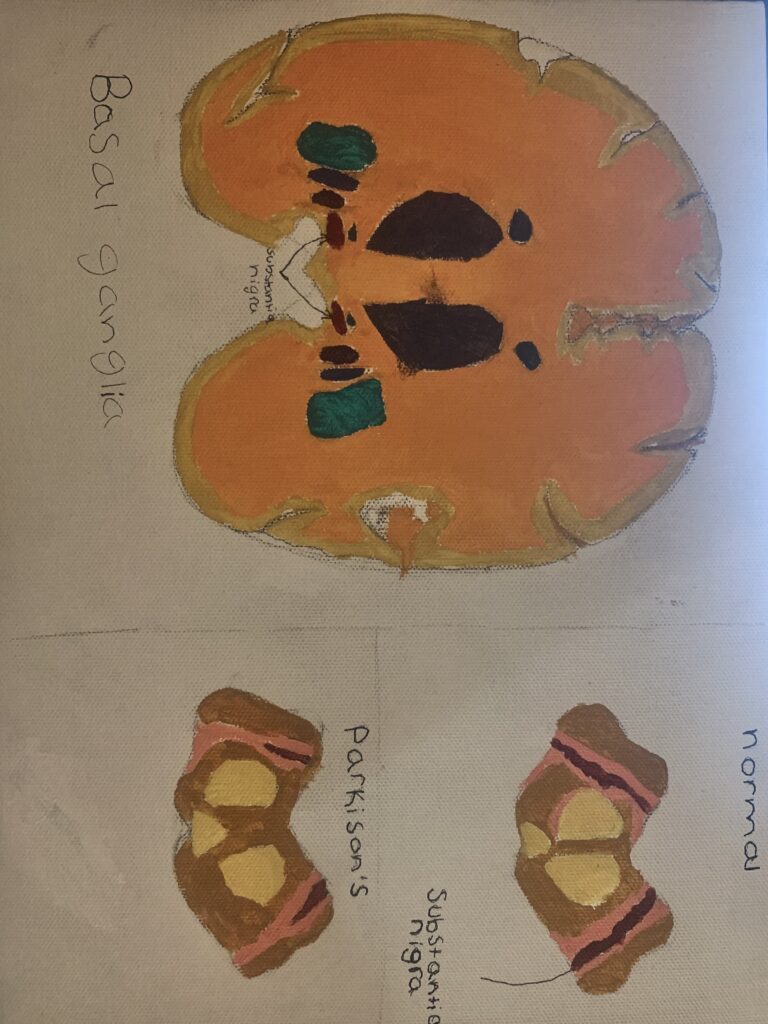
The basal ganglia is the part of the brain that controls motor control for the body, as well as motor learning, executive functions and behaviors, and emotions. Such as walking and using extremities, it also helps with emotions like anxiety and depression. The basal ganglia is made up of a group of structures located within the white matter of the brain. The structures are caudate, putamen, and globus pallidus in the cerebrum, the substantia nigra in the midbrain, and the subthalamic nucleus in the diencephalon. Parkinson’s disease is a brain disorder that leads to shaking, stiffness, and difficulty with walking, balance, and coordination, sometimes depression and or other emotional changes. Most of these symptoms start with small almost unnoticeable symptoms but gradually get worse as the disease goes on.
The reason Parkinson disease shows these symptoms is because it affects the basal ganglia part of the brain. The basal ganglia acts as a circuit for motor control. The two pathways are the excitatory pathway and the Inhibitory pathway. The listed structures above all work together to be able to move certain drugs in the brain like dopamin or inhibitors. The part that Parkinson’s affects is the substantia nigra which is an important part of the circuit due to what it produces. The substantia nigra is especially vulnerable to degeneration because of their extensive branching and the large amounts of energy that is required to send nerve signals along this extensive network. The degeneration of this part of the brain causes the circuit to no longer function normally, cutting off a part of the circuit. This is linked to the loss of dopaminergic neurons as this neuron is responsible for dopamine production. That aids primarily in the movement of the body that is Parkinson effects.
At this point there is no proof or exact known part on what causes the death or lack of work of the Substantia nigra. However there are certain predictions and theories that the death of the substantia nigra is caused by the mitochondria. Which is an organelle inside the body that produces energy such as ATP inside the cells. Mitochondria are able to freely move around to be able to use nutrients to produce O2 and energy, however when they are are damaged they produce reactive oxygen species that are highly destructive that ruin mitochondria and tissue, the death of the neurons is related to the damaged mitochondria not being stopped so they are able to fuse with healthy mitochondria and contaminate them.
Obeso, J., Luquin, N., & Lanciego, J. (2019). Functional Neuroanatomy of the Basal Ganglia. Molecular Biotechnology, 2(12), 1–26. https://www.ncbi.nlm.nih.gov/pmc/articles/PMC3543080/#__ffn_sectitle
Parkinson’s Disease. (2017). NIH National Institution of Aging. https://doi.org/https://www.nia.nih.gov/health/parkinsons-disease ScienceDaily. (2011, November 11). Why do neurons die in Parkinson’s disease? study of hereditary parkinson’s finds that mitochondria can’t be cleared out when damaged. ScienceDaily. Retrieved November 24, 2021, from https://www.sciencedaily.com/releases/2011/11/111110142104.htm.

I guess I never really thought of Parkinson’s disease as being relevant to the brain, I always thought of it as just shaking and trembling movement. To see that it does affect depression and dopamine production, I can now see how the brain function can affect a person with Parkinson’s. I know that there is no cure for Parkinson’s, but that utensils have been created to help people with shaking and trembling. I never thought of Parkinson’s as a brain disorder, but knowing that the brain controls movement, the connection is clear. Like other brain disorders, it does inhibit some movement or other bodily function or brain function. It is amazing how many systems must work correctly in order for our bodies to function right, when something goes wrong, it can be very serious.